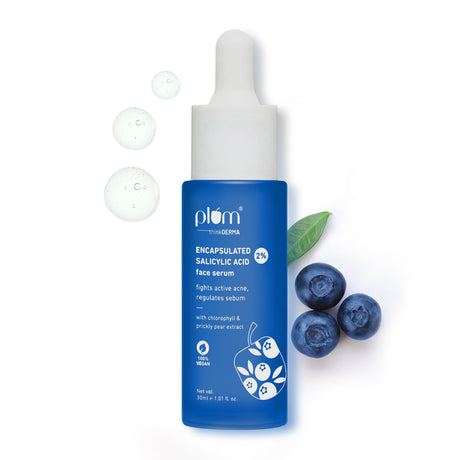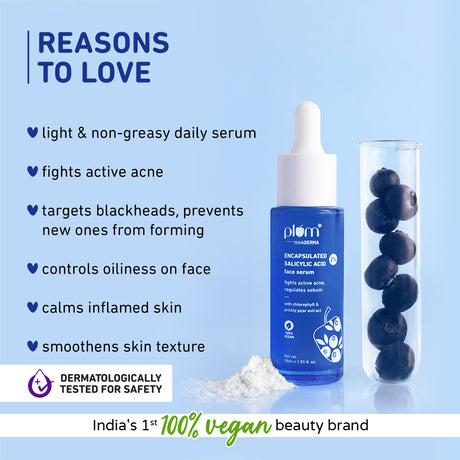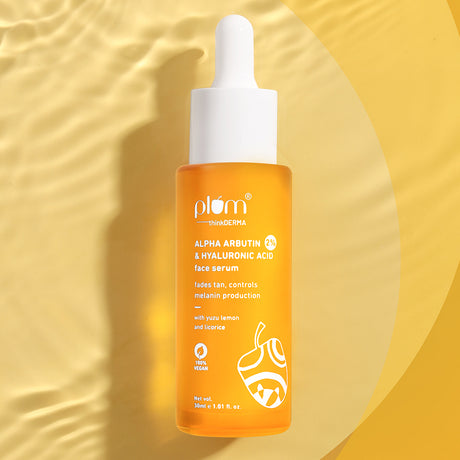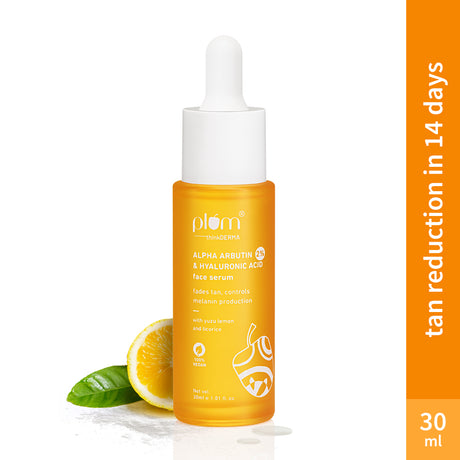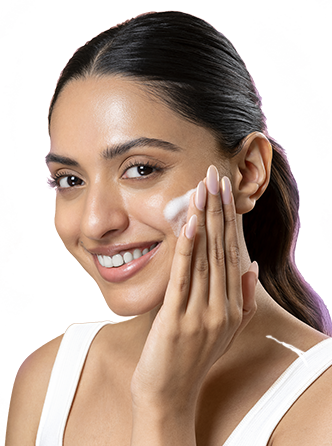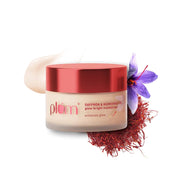
IN THIS ARTICLE
In the skincare universe, facial serums have emerged as a crucial step for getting glowing skin. They penetrate deep into your skin to combat issues like dullness, dryness, dark spots, and signs of aging, giving faster and more effective results.
However, while the question of 'how to use face serums' is frequently posed, the benefits of layering and pairing together often go unnoticed.
Experts believe that marrying two serums elevates the skincare routine and provides targeted results faster.
While layering means using two face serums on top of one another in the same routine, pairing refers to a practice where you can use two face serums together but in different routines, either on alternate days or at different times of the day.
Here we will discuss how to layer face serums.
If you are a fan of face serums (you're missing out if your answer is no!), it's crucial not only to understand how and when to apply face serums but also to understand the correct method of layering them.
To help you with the basics of layering face serums, here is a detailed guide on how to apply face serums and layer them correctly.
Additionally, find a comprehensive guide on skincare ingredients that you can layer together in the same skincare routine. Let's begin.
Why should you layer your face serums?
As you may already know, face serums are lightweight, concentrated formulations of active ingredients that help address specific skin concerns.
And the truth is, only a few lucky people are just one issue away from the coveted, glowing skin. For the rest, it's like an army of skin concerns that need to be addressed.
Learning how to apply face serum effectively helps enhance its absorption and performance on your skin.
When you pair two complementary ingredients, it helps amplify the benefits of each face serum and address multiple issues simultaneously so that you can achieve your skincare goals faster and more effectively.
Knowing how to use face serum the right way helps you get all its skincare benefits.
How to layer serums on the face?
Before you start getting all hyped up about layering different serums, here are a few things you must consider, including how to use serum effectively for the best results.
Stick to two
While layering face serums, you must avoid using more than two active ingredients at a time.
Using too many face serums together can impact their efficacy, neutralizing the benefit of the topmost layer. Additionally, it can be overwhelming for the skin leading to dryness, breakouts, etc.
Consider the concentration
While layering face serums, consider the concentration of each. You should avoid applying two face serums of higher concentration together to prevent adverse effects on the skin.
For example, while using vitamin C serum, avoid layering or even pairing niacinamide with a concentration higher than 5%. Start with a lower concentration of each to avoid a reaction on the skin.
Always do a patch test
Whether you're using a face serum for the first time or trying a new combination, always do a patch test to ensure it's safe for your skin before deciding when to use face serum in your routine.
For a patch test, apply the face serum on a small area of the skin, preferably inside the elbow, and wait at least 24 hours to see its reaction on your skin. If there is no irritation, itching, or redness, it is suitable for your skin.
Moreover, even when trying a new combination, test them separately first.
Start with the lightest
While layering two face serums, consider their textures. Water-based serums should be applied first, followed by oil-based or heavier serums.
Aid complete absorption
After applying your first face serum, allow it to get completely absorbed into your skin before following up with the next, for maximum benefits. Depending on the ingredient or the product you are using, it can take a few seconds to a few minutes for the face serum to get completely absorbed into your skin. This step is crucial in understanding how to use serum properly for the best results.
Layer Your Skincare Products and Learn How to Use Serum Effectively
Face serums should be an addition to your skincare routine and not a substitute. You should always apply a face serum after a face cleanser and toner. Similarly, following up with a nourishing moisturizer and sunscreen (during the day) is a must. After applying serum on face what to do next is to ensure your skin is properly hydrated and protected.
Know the best time when to apply face serum
Not all face serums are meant to be used during the day and vice versa. For example, experts advise that you should use retinol only at night and only 1-3 times a week. Knowing how to use serum, along with understanding the suitability, time, and frequency of each active ingredient, is essential before you add them to your routine.
How to use face serum?
Using face serum might seem intimidating at first, but it's super easy once you get the hang of it, especially when you know when to apply face serum in your skincare routine! Here’s a simple, step-by-step guide of how to use face serum correctly to make it part of your skincare routine:
-
Cleanse Your Face
-
Apply the Serum
-
Let it Soak In
-
Moisturize
-
Sunscreen (AM Only)
The best combinations for different face serums
Hyaluronic acid
Hyaluronic acid is a humectant that attracts moisture from nearby surroundings and draws it into your skin. It makes your skin more plump and hydrated and reduces the appearance of fine lines. It is best to use hyaluronic acid on damp skin.
What can you use with hyaluronic acid?

To target different skin concerns, you can layer hyaluronic acid with all face serums, be it niacinamide, vitamin C, retinol, salicylic acid, alpha arbutin, azelaic acid, kojic acid, etc.
What can you not use with hyaluronic acid?
Hyaluronic acid is a universal active ingredient, and therefore, there are no restrictions on its layering or pairing with other face serums.
Niacinamide
Niacinamide fades blemishes and spots while brightening your skin. It helps smoothen skin texture and improve skin tone.

What can you use with niacinamide?
- Salicylic acid
- Vitamin C (we recommend with 5% niacinamide)
- Alpha arbutin
- Retinol (only at night)
- Azelaic acid
What should you not use with niacinamide
- Avoid pairing a higher concentration of niacinamide with vitamin C in the same routine. It is best to use them on alternate days.
Vitamin C
Vitamin C helps reduce dark spots, pigmentation, and discoloration in your skin. It also hydrates your skin, leaving it glowing and nourished.

What can you use with vitamin C?
- Niacinamide (lower concentration)
- Hyaluronic acid
- Azelaic
- Alpha arbutin
What should you not use with vitamin C
Vitamin C can be intense for your skin and therefore it is suggested to layer it with only gentle actives. You should avoid layering the following with vitamin C.
- Retinol
- Salicylic acid
Salicylic acid
Salicylic acid is the best serum for acne. It fights active acne and regulates excess oil. It also unclogs pores and removes dead skin, reducing the occurrence of breakouts.

What can you use with salicylic acid
- Hyaluronic acid serum
- Niacinamide
- Alpha arbutin
- Azelaic
What should you not use with salicylic acid serum
- Retinol
- Vitamin C
Alpha arbutin
Alpha arbutin helps reduce hyperpigmentation caused by sun tanning. It regulates melanin production and effectively minimizes the appearance of melasma.
What can you pair with alpha arbutin?
- Alpha arbutin is a gentle active ingredient and can be layered with all serums.
Azelaic acid
Azelaic acid kills acne-causing bacteria and unclogs pores. It is a potent antioxidant that helps reduce inflammation and hyperpigmentation caused by acne in dry and sensitive skin.

What can you pair with azelaic acid serum
- Hyaluronic
- Niacinamide
- Vitamin C
- Alpha arbutin
- Salicylic acid (we recommend layering it on alternate days to avoid skin irritation)
- Retinol (to be used only 1-2 times a week at night)
What should you not use with azelaic acid serum
While it is safe to use Retinol and Salicylic acid with azelaic acid, it is advised to use them with extra caution as the combination can irritate your skin.
Retinol
Retinol boosts collagen production in your skin while reducing the appearance of fine lines and wrinkles. Retinol serum is known to be an excellent serum for anti-aging and glowing skin. For best results, you must restrict the usage of retinol to nothing more than twice or thrice a week in the nighttime skincare routine.

What can you use with retinol?
- Hyaluronic acid
- Niacinamide
- Alpha arbutin
- Azelaic
What should you not use with retinol
- Salicylic acid
- Vitamin C
|
Combination for different serums
|
||
|
Serum
|
Can be layered with
|
Cannot be layered with
|
|
Hyaluronic acid
|
All
|
-
|
|
Niacinamide
|
Salicylic acid
Vitamin C (lower concentration)
Alpha arbutin
Retinol (only at night)
Azelaic acid
|
-
|
|
Retinol
(To be used only in the night skincare routine and not more than 2-3 times a week)
|
Hyaluronic acid
Alpha arbutin Azelaic
Niacinamide
|
Salicylic acid
Vitamin C
|
|
Salicylic acid
|
Hyaluronic acid serum
Niacinamide
Alpha arbutin
Azelaic
|
Retinol
Vitamin C
|
|
Alpha arbutin
|
All
|
-
|
|
Azelaic acid
|
Hyaluronic
Niacinamide
Vitamin C
Alpha arbutin
retinol
Salicylic acid
|
-
|
|
Vitamin c
|
Niacinamide ( lower concentration)
Hyaluronic acid
Azelaic
Alpha arbutin
|
Retinol
Salicylic acid
|
Following these tips, you can learn how to layer and pair your serums correctly and achieve your skincare goals. However, if you notice any adverse effects on the skin after prolonged use, discontinue the use and consult a dermatologist.
FAQs
Can we use face serum daily?
Typically, you can use face serums daily. However, since it contains active ingredients in high concentration, it is advised to consider the ingredients and your skin needs before adding them to your daily skincare routine.
For example, you must avoid using retinol serum daily as it can be too harsh for your skin.
What not to do after applying serum?
After applying face serums you should never use any other skincare product immediately. Wait for a few minutes to allow it to get absorbed in your skin before you follow up with a moisturizer and sunscreen.
How to use face serums?
- Dispense two to three drops of face serum on your skin
- Apply it evenly to your face and neck and dab it in
- Follow up with moisturizer and sunscreen
What is the ideal age to start using a face serum?
Face serums are highly potent and concentrated formulations. You can use face serums of mild concentration and less active ingredients, such as hyaluronic acid as early as 16+ of age.
However, you need to be cautious about using face serums with higher concentrations. Also, choose the serums for face according to the ingredients and your skin concerns.







